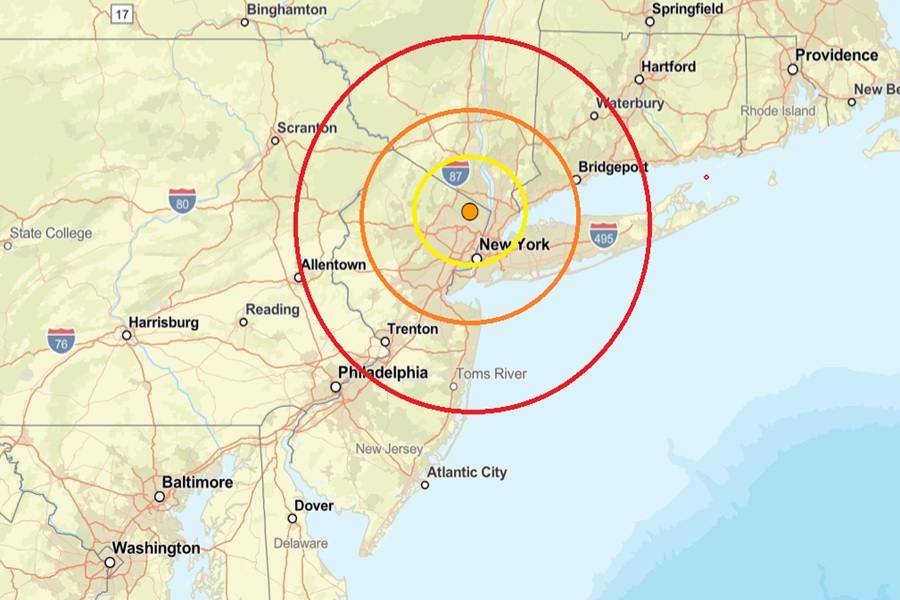
Thousands of people across northern New Jersey and the broader New York City metro area reported to USGS they reported today’s earthquake in the Garden State, the 8th earthquake to strike the area in the last 21 days. According to USGS, today’s magnitude 2.7 event at 12:11 in the afternoon had an epicenter in between Paramus, Ridgewood, and Hillsdale, striking at a depth of 12.4 km. More earthquakes are likely to strike New Jersey in the coming weeks and months ahead as old faults reactivate.
Earthquakes felt in New Jersey are generally few and small. However, some earthquakes have produced damage in New Jersey. While the Garden State’s seismic hazard is lower than many earthquake-prone parts of the United States, USGS says that the hazard is present with the greatest risk of damaging earthquakes in northeastern New Jersey where today’s earthquake struck.

An earthquake also struck northern New Jersey this past weekend; that magnitude 3.0 event struck south of today’s near the town of Hasbrouck Heights. Both struck along a fault that runs through New Jersey.
USGS says that earthquakes with a magnitude of 2.0 or less are rarely felt or heard by people, but once they exceed 2.0 , more and more people can feel them. While damage is possible with magnitude 3.0 events or greater, significant damage and casualties usually don’t occur until the magnitude of a seismic event rises to a 5.5 or greater rated event.
Because of the rock structure of the ground around northern New Jersey, even a weaker earthquake can be felt in more places by more people than an earthquake of similar magnitude in places like California.
“While this earthquake is relatively small globally, earthquakes of this magnitude are commonly widely felt in the eastern United States because of efficient seismic wave propagation in the region,” USGS wrote.
Earthquakes in the eastern U.S. are infrequent but not unexpected. In April 2024, a magnitude 4.8 earthquake occurred near Tewksbury, New Jersey, approximately 35 miles west-southwest of the earthquake which struck this weekend. That earthquake was widely felt across the northeastern United States.
“The August 2, 2025 earthquake is not an aftershock of the April 2024 earthquake given the distance between the two earthquakes; however, felt aftershocks of the April 2024 earthquake do continue to occur,” says USGS.
Since 1950, 43 other earthquakes of magnitude 3 and larger have occurred within 155 miles of today’s earthquake. In that time range, the April 5, 2024, Tewksbury, New Jersey earthquake was the largest.”
This weekend’s earthquake occurred in a region where faults have been previously identified and may be reactivated at any time. As these faults become reactivated, more earthquakes can be expected. Fault reactivation occurs when forces acting on a previously inactive or dormant fault exceed its strength, causing it to slip. This can lead to earthquakes and ground deformation.
Fault reactivation could be occurring near Randolph, New Jersey too. On July 22, an earthquake swarm unfolded there, shaking residents up through 6 separate earthquakes. Like this weekend’s earthquake, this was too far away from the April 2024 earthquake to be part of the same series.
While not as famous as California’s, New Jersey does have does have fault lines, with the most notable being the Ramapo Fault. It’s not as active as fault lines in places like California, but it has been the source of several earthquakes in the past, including the April 2024 event. The Ramapo Fault runs through the northern part of the state, separating the Piedmont and Highlands Physiographic Provinces.
Public awareness of the Ramapo Fault and its potential to cause earthquakes has increased over time, especially after events like the 1970s concerns about its proximity to the Indian Point nuclear plant. This proximity raised concerns about the plant’s safety, particularly in the context of earthquake hazards. Indian Point, which was shut down in 2021, was known to be situated near both the Ramapo Fault and another fault line, the Stamford-to-Peekskill Fault Line.
The uptick in seismic activity in New Jersey has lead to an increase in interest in earthquake insurance, but it isn’t yet clear if that increased interest is driving the actual purchase of policies. According to FEMA, only 10-15% of homeowners across the nation have earthquake policies. Damage from earthquakes are usually not included in standard homeowners insurance; people need a separate policy or an endorsement to an existing one for proper earthquake coverage. Because the risk of damaging earthquakes is lower in New Jersey than California, earthquake insurance in New Jersey is generally cheaper than elsewhere. However, earthquake insurance policies typically have higher deductibles, often ranging from 10% to 20% of the coverage limit. Organizations like the Insurance Information Institute (III) advocate for greater seismic mitigation and resilience investment, possibly leading to more homeowners considering earthquake insurance. But with the state’s low risk and the additional cost associated with the coverage, many homeowners may be deterred from buying additional coverage.
According to III and A.M. Best, $250 million in direct premiums written for earthquake coverage was in force in Connecticut, New Jersey, and New York in 2023, accounting for less than 5 percent of U.S. earthquake coverage premiums.
With more earthquakes happening in recent years and more earthquakes likely as once dormant faults reactivate, the number of policies in the region could change.
In the meantime, New Jersey and surrounding states continue to shake. There have been over a dozen and a half earthquakes in New Jersey over the last 12 months, with 8 of them happening just in the last 30 days. In the last 30 days, there have also been earthquakes in New York and Massachussetts and 2 in Canada close to the border with Maine.